Miyawaki Technique: An Alternate Approach to Urban Forests
Published on: February 8, 2024

What is Miyawaki Technique?
The rapid increase in urbanization has drastically reduced the forest covers all over the world. In such situations of helplessness, people have started to take small but effective steps by undertaking the Miyawaki Technique.
The Miyawaki technique was pioneered by Japanese Botanist Akira Miyawaki. This technique propagates planting native trees in close affinity to each other, which fosters growth.
Features of Miyawaki Technique
- 10x faster growth
- 30x denser growth
- Self sufficiency after 3 years
- 100% organic
How do we execute the Miyawaki technique?
- Procurement of land
- Testing of soil
- Selection of saplings
- Prepping of land
- Plantation of sapling.
Real World Examples
- In September 2020: Indian Navy, in collaboration with Green Yatra (https://www.greenyatra.org/), developed Mumbai’s largest Miyawaki forest
- In July 2020, an urban forest with 12,000 seedlings was inagurated by the Union Environment Minister in the heart of Delhi
- SayTrees, in collaboration with other organizations, developed a forest consisting of 40,000 trees at Indian Railways Institute of Disaster Management (IRIDM), Bengaluru.
Advantages:
The availability of free land is a big problem in urban settings. Miyawaki technique focuses on a small piece of land, where the saplings are planted very close together, which in turn promotes competition within the saplings, for space, water and sunlight. This results in a faster growth rate.
Another advantage is the fact that such forests tend to become self-sufficient, meaning they cease to need maintainence, after about three years.
Disadvantages:
Like every other technique for artificial reforestration, this technique has a few disadvantages. Opponents of this technique argue that such forests cannot replace “natural” forests because they generally lack the biodiversity component of natural forests.
This technique is a chance to a greener future.
The Miyawaki technique has great potential when it comes to limited spaces and resources. It is evident from the success of numerous such forests, both in India and outside, that artificial aforestration is helping reduce pollution and heat in the concerned areas. However, destroying a natural forest and planting a smaller artificial forest in it’s place will harm the natural biodiversity of the region.
At Forengers, an environmental organization, we have got the opportunity to explore this technique and we’re excited to do its actual experimentation.
Not only to set a milestone for us but also to play our part in this fight of ecological restoration and climate change.